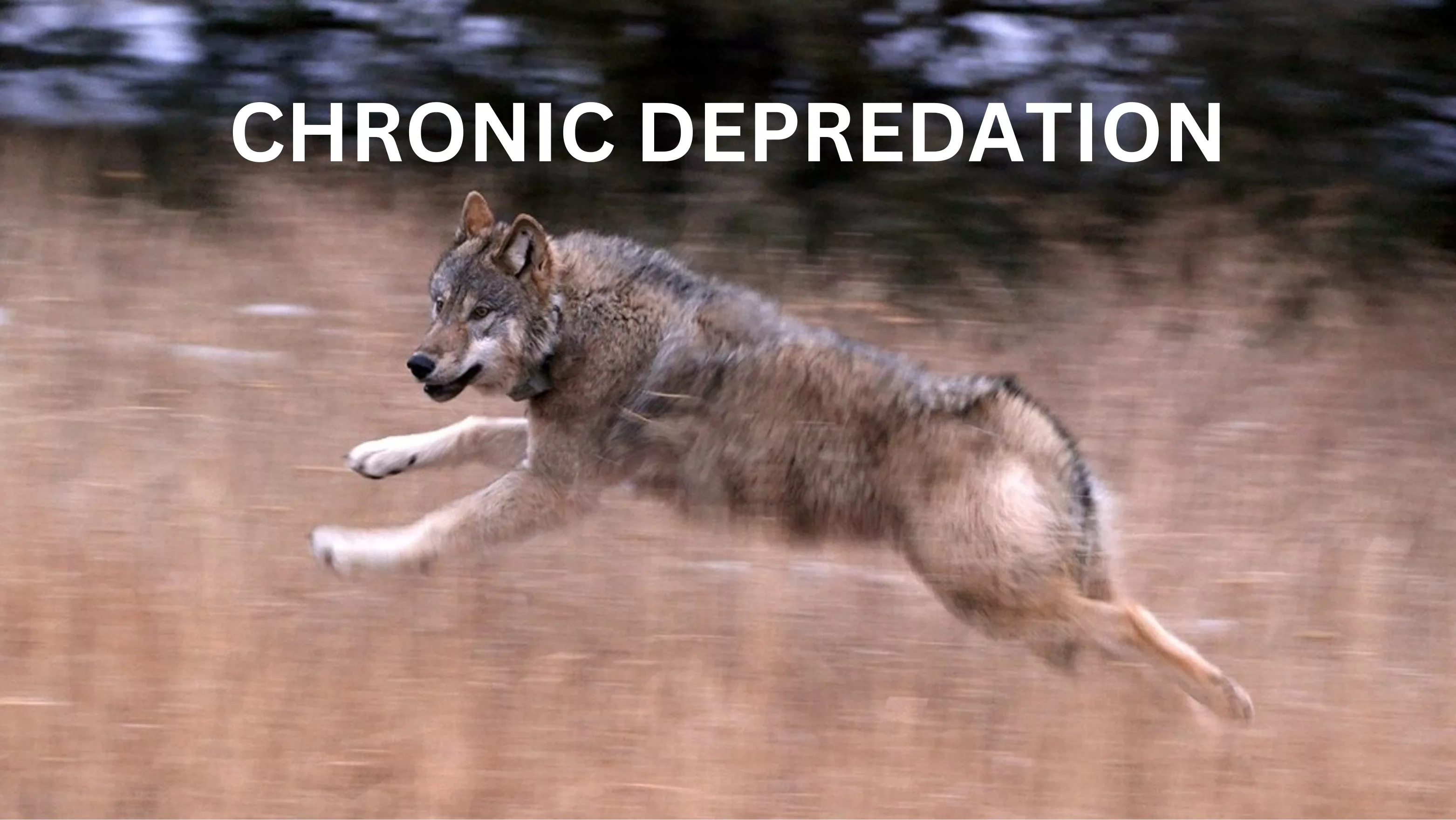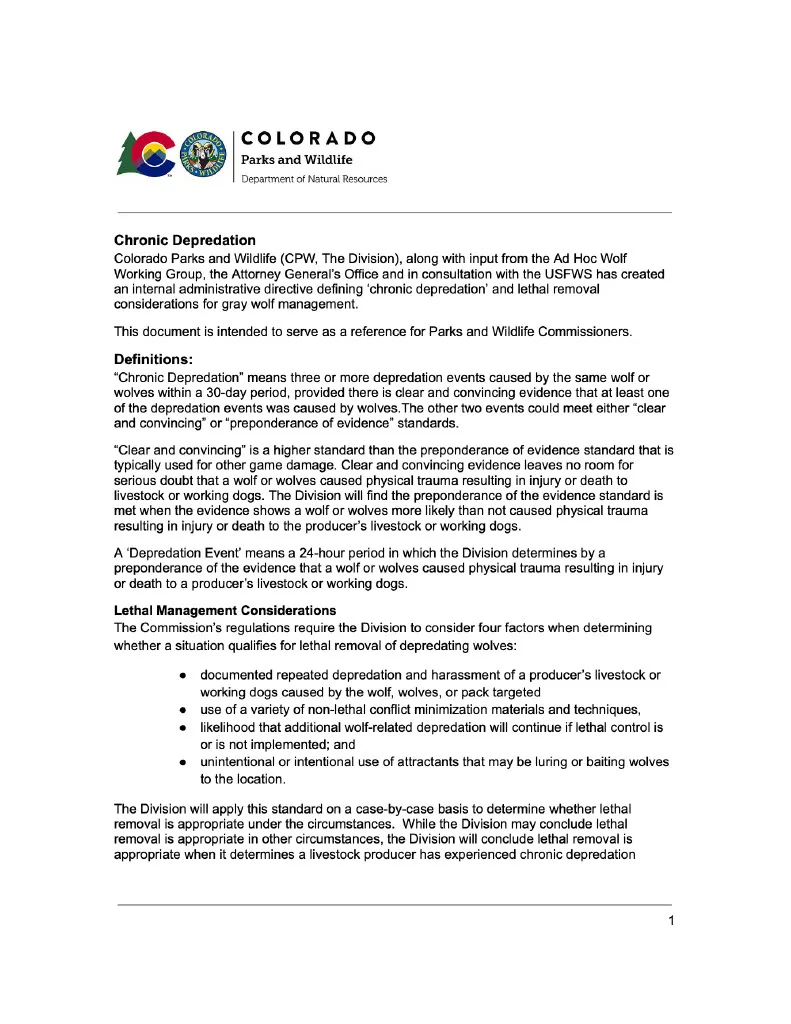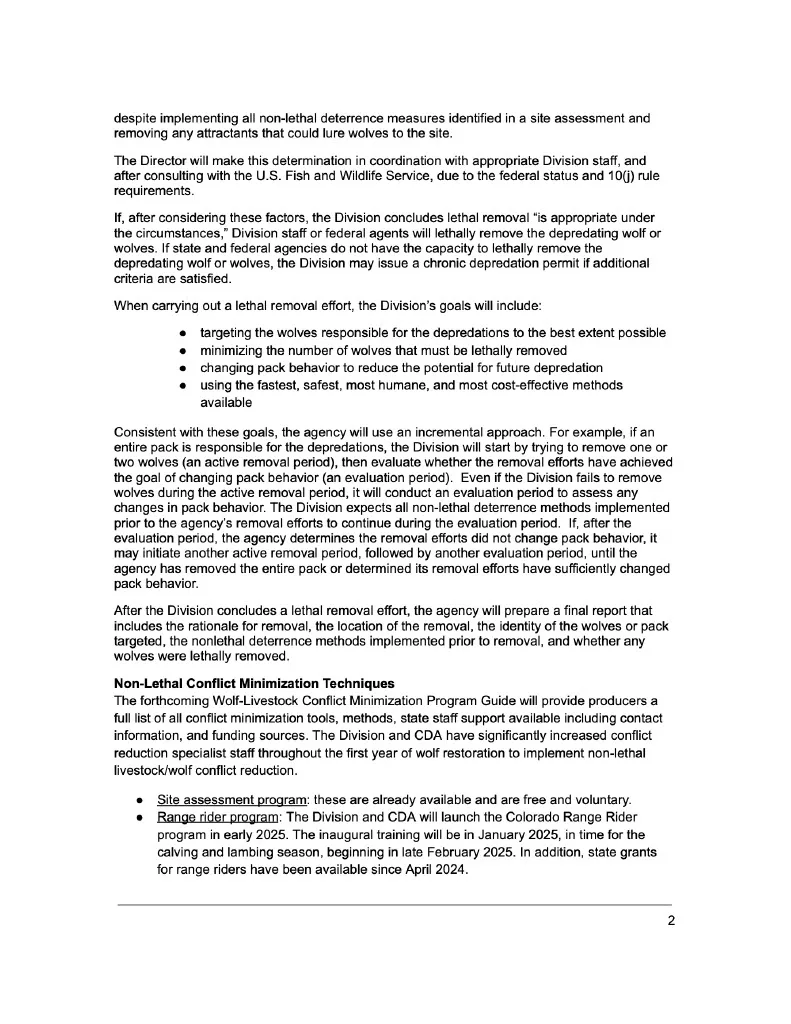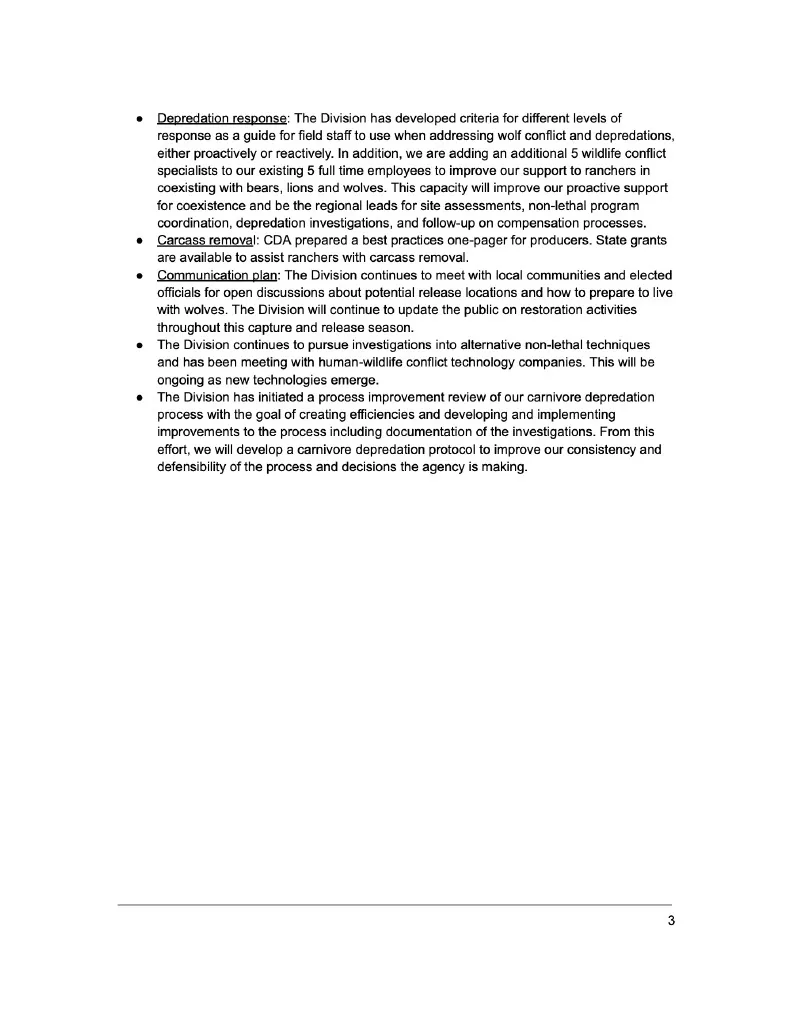
By Shannon Lukens.
Colorado Parks and Wildlife has presented a definition of Chronic Depredation, which is in regards to wolves killing livestock and working dogs. Ranchers have been asking for it. The definition is about two and a half pages long. It says it is three or more depredations caused by the same wolf or wolves within 30 days and it has to be “clear and convincing,” that it is wolves.
The new document then lists four factors for lethal management to be considered. It includes documented repeated depredation and harassment of a producer’s livestock or dogs, non-lethal materials must be used, depredations will continue of lethal control isn’t implemented and wolves cannot be being lured or baited to a location. CPW Director Jeff Davis will make the determination with staff. That full document is listed below.
Also today, Colorado Parks and Wildlife released a Memorandum of Understanding on Gray Wolf Restoration with the Southern Ute Indian Tribe. “MOU formalizes government-to-government relationship and encourages collaboration and information sharing as state moves forward on gray wolf restoration.” It is below as well.
Chronic Depredation from the CPW Website
Here is the document from the Colorado Parks and Wildlife website; Dec. 23, 2024.
Colorado Parks and Wildlife (CPW, The Division), along with input from the Ad Hoc Wolf Working Group, the Attorney General’s Office and in consultation with the USFWS has created an internal administrative directive defining ‘chronic depredation’ and lethal removal considerations for gray wolf management.
This document is intended to serve as a reference for Parks and Wildlife Commissioners.
Definitions:
“Chronic Depredation” means three or more depredation events caused by the same wolf or wolves within a 30-day period, provided there is clear and convincing evidence that at least one of the depredation events was caused by wolves. The other two events could meet either “clear and convincing” or “preponderance of evidence” standards.
“Clear and convincing” is a higher standard than the preponderance of evidence standard that is typically used for other game damage. Clear and convincing evidence leaves no room for serious doubt that a wolf or wolves caused physical trauma resulting in injury or death to livestock or working dogs. The Division will find the preponderance of the evidence standard is met when the evidence shows a wolf or wolves more likely than not caused physical trauma resulting in injury or death to the producer’s livestock or working dogs.
A ‘Depredation Event’ means a 24-hour period in which the Division determines by a preponderance of the evidence that a wolf or wolves caused physical trauma resulting in injury or death to a producer’s livestock or working dogs.
Lethal Management Considerations
The Commission’s regulations require the Division to consider four factors when determining whether a situation qualifies for lethal removal of depredating wolves:
- documented repeated depredation and harassment of a producer’s livestock or working dogs caused by the wolf, wolves, or pack targeted
- use of a variety of non-lethal conflict minimization materials and techniques,
- likelihood that additional wolf-related depredation will continue if lethal control is or is not implemented; and
- unintentional or intentional use of attractants that may be luring or baiting wolves to the location.
If, after considering these factors, the Division concludes lethal removal “is appropriate under the circumstances,” Division staff or federal agents will lethally remove the depredating wolf or wolves. If state and federal agencies do not have the capacity to lethally remove the depredating wolf or wolves, the Division may issue a chronic depredation permit if additional criteria are satisfied.
When carrying out a lethal removal effort, the Division’s goals will include:
- targeting the wolves responsible for the depredations to the best extent possible
- minimizing the number of wolves that must be lethally removed
- changing pack behavior to reduce the potential for future depredation
- using the fastest, safest, most humane, and most cost-effective methods available
After the Division concludes a lethal removal effort, the agency will prepare a final report that includes the rationale for removal, the location of the removal, the identity of the wolves or pack targeted, the nonlethal deterrence methods implemented prior to removal, and whether any wolves were lethally removed.
Non-Lethal Conflict Minimization Techniques
The forthcoming Wolf-Livestock Conflict Minimization Program Guide will provide producers a full list of all conflict minimization tools, methods, state staff support available including contact information, and funding sources. The Division and CDA have significantly increased conflict reduction specialist staff throughout the first year of wolf restoration to implement non-lethal livestock/wolf conflict reduction.
● Site assessment program: these are already available and are free and voluntary.
● Range rider program: The Division and CDA will launch the Colorado Range Rider program in early 2025. The inaugural training will be in January 2025, in time for the calving and lambing season, beginning in late February 2025. In addition, state grants for range riders have been available since April 2024.
● Carcass removal: CDA prepared a best practices one-pager for producers. State grants are available to assist ranchers with carcass removal.
● Communication plan: The Division continues to meet with local communities and elected officials for open discussions about potential release locations and how to prepare to live with wolves. The Division will continue to update the public on restoration activities throughout this capture and release season.
● The Division continues to pursue investigations into alternative non-lethal techniques and has been meeting with human-wildlife conflict technology companies. This will be ongoing as new technologies emerge.
● The Division has initiated a process improvement review of our carnivore depredation process with the goal of creating efficiencies and developing and implementing improvements to the process including documentation of the investigations. From this effort, we will develop a carnivore depredation protocol to improve our consistency and defensibility of the process and decisions the agency is making.
DENVER – The State of Colorado through Colorado Parks and Wildlife (CPW) and the Southern Ute Indian Tribe (Tribe) announce the signing of a memorandum of understanding (MOU) on coordination and communication regarding CPW’s efforts to restore gray wolves in Colorado and the potential impacts on the Tribe’s Reservation and the Brunot Treaty Area in Southwestern Colorado.
The MOU establishes a formal framework for continued collaboration between the sovereigns as the State continues to implement the Colorado voter approved program to restore and manage gray wolves in accordance with the Colorado Wolf Restoration and Management Plan. At the same time, the MOU simultaneously recognizes the sovereign authority of the Tribe on its Tribal lands and the Tribe’s treaty protected off-Reservation hunting, fishing, and gathering rights in the Brunot Treaty Area.
The MOU also builds upon a previous MOU signed in 2008, concerning wildlife management and enforcement in the Brunot Treaty Area, further supports the Tribe’s inherent sovereignty, and is the primary recommendation that was advanced from the formal consultation meetings between the State and the Tribe held from 2022 – 2023, prior to the finalization of the Colorado Wolf Restoration and Management Plan.
“The Colorado Department of Natural Resources and its Division, Colorado Parks and Wildlife greatly appreciate our relationship with the Southern Ute Indian Tribe and are committed through this MOU to promote continued cooperation and communication between the Tribe and the State in our efforts to restore the gray wolf to Colorado,” said Jeff Davis, Director, Colorado Parks and Wildlife. “The Tribe has a wide variety of interests both on its Tribal lands and in the Brunot Treaty Area and we look forward to maintaining our positive working relationship on managing and co-stewarding wildlife within these lands.”
CPW and the Tribe are committed to operating on a basis of a government-to-government relationship that simultaneously recognizes and respects Tribal sovereignty. The MOU also states that CPW and the Tribe will work together to provide a process to minimize conflicts, memorialize a process for information sharing on gray wolf reintroductions throughout the State and confirm the Tribe’s intent to participate in the State’s program to provide fair and timely compensation to the Tribe or Tribal Members for any losses of livestock proven to be caused by gray wolves.
“The Southern Ute Indian Tribe acknowledges and appreciates the Colorado Department of Natural Resources and Colorado Parks and Wildlife’s commitment to fostering a strong and collaborative relationship with our Tribe. We recognize the importance of continued cooperation and communication in all matters pertaining to wildlife management. As the oldest continuous residents, we have a deep and unique connection to the land and its wildlife. We look forward to working constructively with the State to ensure that the reintroduction of the gray wolf is conducted in a manner that respects Tribal sovereignty, upholds our cultural values, and minimizes potential impacts on our Tribal Members, their livelihoods, and our traditional ways of life,” shared Chairman Melvin J. Baker of the Southern Ute Indian Tribe.
The Brunot Area is approximately 3.7 million acres of the San Juan Mountain region within the State of Colorado established by a 1873 Agreement, and contains an important provision reserving for the Utes the right to “hunt upon said land so long as the game lasts and the Indians are at peace with the white people.” Based on historical evidence and testimonials from Ute elders, this reserved right includes not only hunting but also fishing and gathering activities by which the Utes supported themselves in the region for centuries prior to the Agreement. The Utes continue to use the Brunot Area for hunting, fishing, and to gather ceremonial plants.
The MOU also sets out that CPW will ensure that a minimum 60-mile buffer exists between wolf release sites, the Utah state line, and the exterior boundaries of the Reservation and not conduct wolf releases within the boundaries of the Brunot Area. This 60-mile buffer zone is currently included in CPW’s Colorado Wolf Restoration and Management Plan and was developed through past Tribal consultation efforts.
Currently, operational planning is underway for the second capture and release season in support of the Colorado Gray Wolf Restoration and Management Plan. The operation is focused on translocating up to 15 gray wolves from British Columbia to Colorado between January and March, 2025, as announced by Colorado Parks and Wildlife (CPW) in September. To read more about CPW and the Colorado Department of Agriculture (CDA) efforts to work with Colorado livestock producers on a robust program that includes new tools, support and resources to minimize wolf-livestock conflict, see CPW/CDA press release of December 9, 2024.
Steamboat Radio News Past Coverage of wolves in Colorado
- Dec. 23, 2024 — CPW releases definition and stipulations of Chronic Depredation and Lethal Management of wolves
Dec. 21, 2024 — CPW says they’ll recommend denying petition request for delaying next introduction of wolves - Dec. 9, 2024 — Colorado Parks and Wildlife has started the operation to bring 15 gray wolves to Colorado from British Columbia
- Nov. 14, 2024 — Wolf Update — November 14, 2024
- Nov. 3, 2024 — A collared wolf has crossed I-70 to the south, for the first time
- Nov. 3, 2024 — CPW responds to requests from Club 20 about Wolf Reintroduction
- Oct. 15, 2024 — Livestock producers have access to livestock protection dogs for free from USDA
- Oct. 11, 2024 — Fifth wolf pup has not been captured
- Oct. 8, 2024 — CPW Commission gets another letter asking to pause wolf reintroduction
- Oct. 6, 2024 — CPW Commission hears wolf updates at meeting
- Sept. 30, 2024 –– A 5th wolf pup is spotted in Grand County and will be captured by CPW
- Sept. 30, 2024 — Colorado Ag Organizations petition CPW Commission before further wolf releases happen
- Sept. 26, 2024 — No producers show for first Non-Lethal Wolf Conflict Reduction Training Meeting
- Sept. 23, 2024 — CPW confirms a cow and a calf killed by wolves in Grand County
- Sept. 16, 2024 — The Wolf Conflict Reduction program is hiring two field specialists
- Sept. 14, 2024 — The next set of wolves coming to Colorado will be from Canada
- Sept. 13, 2024 — Middle Park Stockgrowers ask CPW not to release any more wolves there
- Sept. 12, 2024 — Another wolf is dead in Grand County
- Sept. 10, 2024 — Grand County ranchers are reporting more wolf kills
- Sept. 9, 2024 — The Copper Creek Wolf Pack has been captured and CPW says the adult male was unhealthy and has died
- Sept. 9, 2024 –– Ranchers with the most wolf depredations ask U.S. Fish & Wildlife to take over wolf management
- Aug. 27, 2024 — The Copper Creek Wolf Pack is getting rounded up and relocated
- Aug. 23, 2024 — CPW confirms the next wolves introduced will again be in Northern Colorado
- July 31, 2024 — Eight more sheep confirmed killed by wolves in Grand County
- July 31, 2024 — Colville Tribe says they won’t send wolves to Colorado now
- July 29, 2024 — Two more sheep die from wolves in Grand County
- June 24, 2024 — CPW REPORTS LESS WOLF ACTIVITY IN ROUTT AND NONE IN MOFFAT
- June 20, 2024 — WOLF PUP CONFIRMED IN GRAND COUNTY
- June 19, 2024 — CPW CONFIRMS SOUTH ROUTT WOLF KILL
- June 17, 2024 — PRODUCER REPORTS SUSPECTED WOLF KILL IN SOUTH ROUTT COUNTY
- June 16, 2024 — CPW DIRECTOR JEFF DAVIS ANSWERS QUESTIONS AT JACKSON COUNTY GATHERING
- June 13, 2024 — CPW TO FORM WORKING GROUP REGARDING WOLF RESTORATION
- June 12, 2024 — NORTH PARK PRODUCER WHO LOSES CALF SPEAKS OUT
- June 10, 2024 — CPW CONFIRMS ANOTHER WOLF DEPREDATION IN JACKSON COUNTY THIS WEEKEND
- June 5, 2024 — Wolf Video posted from Grand County
- May 26, 2024 — DON GITTLESON SAYS ANOTHER CALF HAS BEEN KILLED BY WOLVES ON HIS RANCH
- May 15, 2024 — HERE’S THE LATEST LETTER TO MIDDLE PARK STOCKGROWERS FROM CPW DIRECTOR DAVIS
- May 14, 2024 — Suspected mountain lion kills the collared wolf
- May 6, 2024 — MIDDLE PARK STOCKGROWERS SEND EIGHT-PAGE LETTER TO CPW
- April 30, 2024 — GRAND COUNTY RANCHERS TO GET HELP WITH PROTECTING THEIR LIVESTOCK
- April 30, 2024 — NORTH PARK STOCKGROWERS SEND ANOTHER LETTER TO CPW AND GOV. POLIS
- April 28, 2024 —ANOTHER WOLF KILL IN GRAND COUNTY SUNDAY
- April 24-2024 — COLLARED GRAY WOLF ACTIVITY MAP RELEASED FOR APRIL
- April 23, 2024 — A WOLF HAS DIED, AND MIDDLE PARK STOCKGROWERS HEAR FROM CPW
- April 22, 2024 — MULTIPLE LETTERS SENT TODAY TO GOVERNOR POLIS AND CPW ASKING FOR ACTION ON WOLVES
- April 18, 2024 — FOUR MORE HEAD OF LIVESTOCK KILLED BY WOLVES IN GRAND COUNTY
- April 9, 2024 — AG PRODUCERS MEET WITH CPW OFFICIALS IN KREMMLING ABOUT WOLVES
- April 8, 2024 — ANOTHER CALF KILLED BY A WOLF OR WOLVES IN JACKSON COUNTY
- April 3, 2024 — A WOLF OR WOLVES HAVE KILLED A NEWBORN CALF IN GRAND COUNTY
- April 3, 2024 — Denver 7 Calf killed in first confirmed report of gray wolf depredation since wolves were released in December
- Feb. 29, 2024 — COLORADO PARKS AND WILDLIFE OFFICIALS COME TO STEAMBOAT SPRINGS TO TALK WOLVES
- Jan. 30, 2024 — CPW SENDS UPDATE ON WOLF SIGHTINGS SINCE 2004, AND MORE ON THE MAP
- Jan. 24, 2024 — ELECTED OFFICIALS GRILL DEPT. OF NATURAL RESOURCES AND CPW AT HEARING WEDNESDAY
- Jan. 22, 2024 — CPW GETS HARSH LETTER DEMANDING ANSWERS FROM ROBERTS AND MCCLUSKIE
- Jan. 19, 2024 — COLORADO’S NEXT WOLVES TO BE REINTRODUCED WILL BE FROM TRIBAL LANDS IN WASHINGTON
- Jan. 12, 2024 — CPW CONFIRMS WOLVES WERE IN SOUTH ROUTT BUT AREN’T (YET) IN MOFFAT
- Dec. 22, 2023 — FIVE MORE WOLVES ARE RELEASED BY COLORADO PARKS AND WILDLIFE
- Dec. 22, 2023 — CPW DENIES GITTLESON’S REQUEST TO IMPLEMENT 10(J) RULE ON JACKSON COUNTY WOLVES
- Dec. 21, 2023 — THREE OF THE FIVE WOLVES RELEASED IN COLORADO WERE IN PACKS THAT KILLED OR INJURED LIVESTOCK IN OREGON
- Dec. 19, 2023 — LIVESTOCK PRODUCERS RECEIVE WOLF UPDATE FROM CPW IN CRAIG MONDAY
- Dec. 13, 2023 — GITTLESON SAYS ANOTHER CALF WAS ATTACKED BY A WOLF TODAY
- Dec. 11, 2023 — COMPLAINT FILED IN U.S. DISTRICT COURT TO STOP WOLF REINTRODUCTION IN COLORADO
- Dec. 4, 2023 — KEEP YOUR PETS CLOSE AND CARRY A BIG STICK – CPW HAS ADVICE FOR LIVING WITH WOLVES
- Nov. 19, 2023 — THREE LAMBS KILLED BY A WOLF IN JACKSON COUNTY, SAYS RANCHER
- Nov. 17, 2023 – CPW AND CDA ANNOUNCE AGREEMENT TO WORK TOGETHER ON WOLF REINTRODUCTION
- Nov. 7, 2023 – U.S. FISH AND WILDLIFE SETS DATE FOR 10J RULE FOR WOLVES
- Oct. 6, 2023 – COLORADO WILL RECEIVE WOLVES FROM OREGON
- May 16, 2023 – POLIS VETOES 10J RULE WOLF BILL
- May 3, 2023 – CPW COMMISSION APPROVES FINAL WOLF RESTORATION AND MANAGEMENT PLAN
- May 2, 2023 – MANAGEMENT OF GRAY WOLVES REINTRODUCTION BILL PASSES IN STATE HOUSE
- May 2, 2023 –CPW MEETS THIS WEEK FOR FINAL WOLF MANAGEMENT PLAN
- April 27, 2023 – CPW CONFIRMS WOLF SIGHTING EAST OF KREMMLING
- April 8, 2023 – CPW WOLF COMMISSION MEETS IN STEAMBOAT SPRINGS
- April 3, 2023 – CPW TO PRESENT FINAL DRAFT WOLF RESTORATION AND MANAGEMENT PLAN IN STEAMBOAT SPRINGS
- March 28, 2023 – THE SOUTHERN UTE TRIBE ASKS THAT CPW RELEASES WOLVES ALONG I-70 CORRIDOR
- March 15, 2023 – TWO DOGS DIE FROM WOLVES IN JACKSON COUNTY THIS WEEK
- March 3, 2023 –COLORADO PARKS AND WILDLIFE COMMISSION RELEASES WOLF REINTRODUCTION MEETING RECAP
- Feb. 21, 2023 —WOLF 2101 RECAPTURED AND RECOLLARED IN JACKSON COUNTY
- Feb. 21, 2023 —10J RULE MEETINGS WITH REGARDS TO WOLVES SCHEDULED FOR NW COLORADO BY US FISH AND WILDLIFE
- Jan. 17, 2023 —STATE LEGISLATORS HEAR MORE ON WOLF REINTRODUCTION AT JOINT COMMITTEE HEARING
- Dec. 13, 2022 —MORE WOLVES VISIT GITTLESON PROPERTY IN JACKSON COUNTY THIS WEEK
- Dec. 12, 2022 —NORTH PARK RANCHERS MEET WITH CPW REGARDING WOLF REINTRODUCTION PLAN
- Dec. 10, 2022 —CPW RELEASES DRAFT COLORADO WOLF RESTORATION AND MANAGEMENT PLAN
- Nov. 19, 2022 —ANOTHER WOLF ATTACK REPORTED IN JACKSON COUNTY
- Oct. 9, 2022 —WOLVES ATTACK CALVES IN RIO BLANCO AND JACKSON COUNTIES
- July 14, 2022 —CPW UPDATES THE WOLF PACK IN JACKSON COUNTY
- June 20, 2022 ––WOLF MANAGEMENT DISCUSSED AT MEETING IN WALDEN
- June 15, 2022 —WOLVES IN NORTH PARK ARE SUBJECT AT MEETING MONDAY, JUNE 20
- May 30, 2022 —THE GITTLESON RANCH LOSES ANOTHER CALF TO WOLVES, THEY SAY
- May 5, 2022 —AT LEAST TWO MORE CALVES KILLED BY WOLVES ON GITTLESON RANCH
- May 10, 2022 ––THIRD CALF DIES ON JACKSON COUNTY RANCH; CPW DOES NECROPSY
- April 11, 2022 —A NEW LITTER OF WOLF PUPS IS EXPECTED IN JACKSON COUNTY
- March 17, 2022 —WOLVES ATTACK ANOTHER DOMESTIC COW IN JACKSON COUNTY
- Feb. 10, 2022 – MONTANA STOCKGROWERS VOICE SUPPORT FOR COLORADO RANCHERS OVER THE WOLVES
- Feb. 9, 2022 – WOLF MANAGEMENT DISCUSSED BY LOCAL RANCHERS AND OFFICIALS AT FORUM IN STEAMBOAT
- Jan. 22, 2022 – WOLF MITIGATION OPTIONS
- Jan. 19, 2022 – ANOTHER COW KILLED OVERNIGHT IN NORTH PARK BY WOLVES
- Jan. 18, 2022 – TWO MORE COWS ATTACKED BY WOLVES IN JACKSON COUNTY TUESDAY
- Jan. 12, 2022 – CPW ALLOWS WOLVES TO BE HAZED IN EMERGENCY DECLARATION
- Jan. 10, 2022 – A WOLF PACK KILL IS REPORTED IN JACKSON COUNTY OVER THE WEEKEND
- June 9, 2021 – WOLF DEN WITH PUPS CONFIRMED IN NW COLORADO


